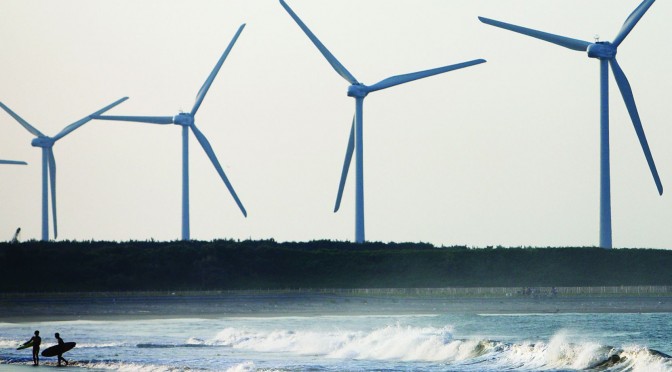Japan has declared its goal to be carbon neutral by 2050, and the government intends to increase the number of offshore wind power plants (OWPPs) to the greatest extent possible. It has completed public tenders to produce 1.57GW in general sea areas other than ports (ippan kaiiki). It also plans to pursue projects to produce 10GW by 2030, and 30-45GW by 2040.

Partner at TMI Associates in Tokyo
Email: koji_fukatsu@tmi.gr.jp
Further to the construction and operation of OWPPs in Japan’s ippan kaiiki, the Ministry of Economy, Trade and Industry (METI) and the Ministry of Land, Infrastructure, Transport and Tourism (MLIT) have designated promotion zones in which OWPPs will be developed. The ministries have also established guidelines for submitting public tenders for exclusive occupancy and use of sea areas within each promotion zone.
Persons intending to build and operate OWPPs in accordance with the guidelines should prepare and submit an exclusive occupancy and use plan through public bidding. The selected bidder may build and operate OWPPs upon receiving a permit from the MLIT for the exclusive occupancy and use of the sea area in the promotion zone. After certification of a renewable business plan by the METI, in principle, electricity will be purchased at a fixed price for 20 years via a feed-in tariff (FIT) scheme. After the FIT period expires, the permit may be renewed so that electricity may be traded on the market.
Promotion zones
The METI and the MLIT will designate areas as promotion zones that meet requirements such as: An expectation of considerable power output; the existence of base ports for construction, operation and maintenance; available grid access; and no expectation of interference with fisheries.
While a public tender will be implemented for only one promotion zone (offshore Happo Town and Noshiro City) at the moment, there are seven locations considered to be promising areas. Once a promising area is selected, a council consisting of interested parties such as local government leaders and relevant fishery organisations will be assembled. The council will consult with interested parties regarding the designation of a promotion zone, and discuss points the public tender should consider.
Guidelines and plans
The METI and the MLIT will present guidelines for each promotion zone, and persons intending to build and operate OWPPs in the promotion zone should submit a plan. The guidelines will be based on the Operational Guidelines for the Public Tender for the Exclusive Occupancy and Use of Ippan kaiiki, issued by the METI and the MLIT. The guidelines for a newly designated promotion zone will thus be similar to the preceding guidelines.
The submitted plans should include the areas and periods of exclusive occupancy and use of the sea areas within the promotion zones, the methods and timing of construction, the operation and maintenance of OWPPs, the ports, and the methods of removal. In addition, the following items should be included:
- Applicant information. Each bidder must be a Japanese entity and, in the case of a consortium, all members must be a Japanese entity. Foreign companies may be members of a special purpose company (SPC) bidder. A proven track record of offshore civil engineering work (in Japan and abroad) and a sound financial status are also required.
- Supply price and FIT period. The maximum electricity supply price of the public tender for the promotion area of Happo Town and Noshiro City will be JPY28 (USD0.25) per kWh. The FIT period will be 20 years, but if the construction of the OWPPs is delayed and operations begin after the scheduled commencement date, the period of such delay will be deducted from the 20 years. The bidder should set the scheduled operations commencement date up to eight years after the approval date of the FIT certification. Applications for the FIT certification must be filed within a year from the date of selection in the public tender.
- Co-ordination with local governments. Bidders must demonstrate their internal system to co-ordinate with local governments and the previous results of such co-ordination.
- Co-operation and co-existence with fisheries. Each bidder is required to present its policy of co-operation and co-existence with the relevant fisheries and shipping companies, and its plan for addressing the council’s concerns attached to the guidelines.
Selection process
First, a conformity test will be conducted to determine whether the plan submitted in the public tender is appropriate in light of the guidelines, and whether the OWPPs and operation or maintenance methods conform to the provided standards. Plans that pass the conformity test will be evaluated according to the set evaluation criteria.
The maximum score of the evaluation is 240 points, of which 120 points are based on electricity supply prices. The formula is 120 X (A/B), where A is the minimum supply price quoted by any plan that has passed the conformity test and has not been disqualified in the evaluation of the feasibility of the project, and B is the supply price in the plan
The remaining 120 points are allocated for the capacity to implement the project (80 points) and the co-ordination with, and benefits to, the local community (40 points). Capacity to implement the project includes items such as: A project implementation track record (30 points); feasibility of the project plan (20 points); and the appropriate identification of and responses to risks (15 points).
The co-ordination with and benefits to the local community consist of the ability to co-ordinate with local governments (10 points), co-operation and co-existence with fisheries (10 points), and benefits to the regional and national economy through the formation of supply chains (20 points).
For each item, the top bidder receives a score of 100%, the middle bidder receives a score of 70%, and a bidder meeting the minimum requirements receives a score of 30%. A bidder that does not meet the minimum requirements receives a score of 0%. A bidder that falls far below the minimum requirements is considered “inappropriate” and is disqualified, regardless of the number of points for other items. The plan of a successful bidder (appointed operator) will be certified, and the area and period of exclusive occupancy and use will be publicly announced with an outline of the plan.
Permit for exclusive occupancy
Once the plan is certified, the MLIT will grant a permit to the appointed operator. The period of exclusive occupancy and use for OWPPs is 30 years from the date of the permit. However, this will be limited to the period during which the plan certification is valid. After the plan certification expires, the permit for exclusive occupancy and use may be renewed. The MLIT may impose conditions on the permit, including the written approval of the fisheries that are members of the council before applying for the permit, and using a port after due consultation with parties that use the same port.
Changes to the plan
The appointed operator must build, operate and maintain OWPPs under the certified plan. If the plan is changed, the appointed operator must obtain the certification of the METI and the MLIT. If the change is minor, submitting an ex-post notification is sufficient. Any change in the plan will be approved only if the changed plan passes the conformity test, and the change is likely to contribute to the further promotion of the public interest, or the change is unavoidable. Further promotion of the public interest includes appropriate changes to the construction method due to new technological knowledge, or appropriate changes to the OWPPs due to technological innovation.
If a change in the shareholders of the appointed operator has a great impact on the likelihood of the project being carried out – such as a change in the majority shareholder; the withdrawal of the shareholder that was subject to the public tender evaluation of the implementation and management of the project; and where the total ratio of voting rights held by shareholders subject to the public tender evaluation falls below 66.7% before the commencement, or below 50% after the commencement, of operations – the METI and the MLIT will carefully review the impact of the changes and consider whether the project will be appropriately implemented after such change.
Conclusion
It is not yet clear how each plan will be evaluated in the bidding process because an appointed operator (the sole bidder in the public tender) has been selected for only one promotion zone. As offshore wind energy in Japan is at its early stages, the guidelines and evaluation points may change.
law.asia


